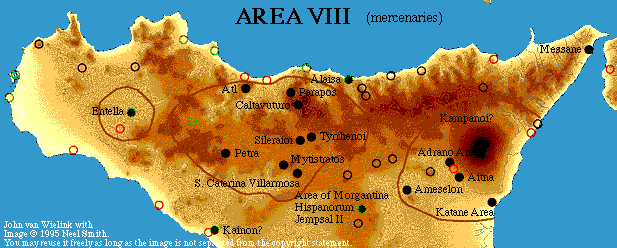
[city list Area VIII] [info]
MERCENARY HISTORY
433 BC Corinth started to pay barbarian tribes as auxilary troops.
415-413 BC Athenian expedition (134 ships, 32000 men). The immediate cause was the
quarrel between Segesta (ally of Athena) and Selinous, about the fertile plain
in between their cities. The cause was the rising power of Syracuse, threatening
the Chalcidian cities Naxos and Leontinoi (also allies of Athena).
414 BC Athenian army used Etruscan mercenaries (the Tyrrhenoi) against the Syracusians.
Other mercenaries in the Athenian army were Japigi and Messapi, recruted by the
Athenians on their way to Sicily.
413 BC Campanian mercenaries, recruted by the Chalcidian cities to reinforce the
Athenian army, arrived when the Athenian army was already defeated. In 410 BC
they were hired by the Carthaginians.
Syracuse was temporary weakened by the war, giving Carthago the opportunity to
extend their sphere of influence.
410 BC Carthaginians payed 5000 Lybians. The 800 Campanians were sent as cavalry to
help Segesta against Selinous. The Carthaginians were against a too powerful
Selinous. If victorious over Segesta they controled a strip land from the south
coast to the north coast.
409 BC Hannibal gathered more mercenaries in Spain, Baleares and African cities under
Carthaginian control. 100,000, according to others 200,000.
409 BC Selinous sacked by Carthago (and Segesta)
409 BC Himera ,, Campanian mercenaries discharged (they settle? in Alaisa on
Carthaginian territory)
406 BC Akragas ,,
405 BC Gela ,,
405 BC Camarina ,,
Segesta actually became subject to Carthage.
Aitna revolted against Dionysius. The Campanian mercenaries of Alaisa were
hired (1200 man cavalry). They left their goods in Agyrion.
404 BC Aitna captured. Campanian mercenaries discharged and sent to Entelle. It is said
that they killed the young man and married the women. First example of
settlement with violence.
403 BC Katane conquered by Dionysius. Houses granted to the mercenaries. Later they
were transferred to Aitna (easier to defend).
402 BC Construction of a new defensive wall around Syracuse with the help of
mercenaries.
399 BC Reinforcement of the Syracusan fleet under Dionysius.
398 BC Payment for mercenaries increased. One bronze drachm a day (daily living
allowance) and at the end of the month coins of intrinsic value (a gold daric or
cysticenus, equivalent to 20 Attic drachms).
397 BC Syracusan army composed of Syracusans, other Sicilian Greeks and mercenaries
from different countries.
Motya conquered, sacked and destroyed by Dionysius army.
395 BC War with Carthaginians ended. Revolt of 10,000 mercenaries (Dionysius had
dificulties in paying their wages). They were granted with the city and the
territory of Leontinoi.
387 BC Dionysius conqueres Rhegion. The wives of the citicens were given to the
mercenaries.
396 BC Carthaginian army reorganized after the defeat of Motya. African and Spanish
mercenaries. 100,000, according to others 300,000.
The Carthaginians adopted the same solution for the discharge and settlement of
the mercenaries in the areas under their domination. This applies to the cities
of Solous, Segesta, Panormos and Entella.
information from Calciati R (1987)
